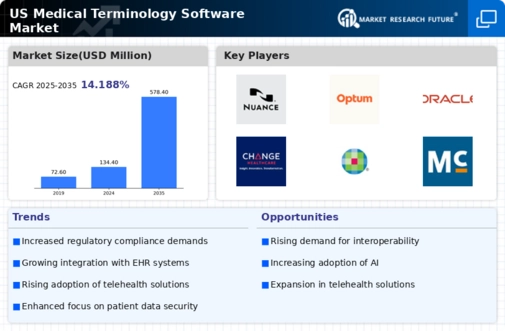The competitive landscape of the US Medical Terminology Software Market is characterized by a dynamic and rapidly evolving environment that responds to the increasing demand for efficient healthcare management solutions. Innovation and technological advancements play a crucial role as companies strive to enhance their offerings, ensuring they meet the rigorous standards required by healthcare professionals.
As healthcare providers increasingly recognize the importance of accuracy in medical documentation and coding, the software solutions that facilitate these processes have garnered significant attention. With the growth of telemedicine and the ongoing digital transformation within the healthcare sector, the market is poised for continued expansion as both new entrants and established players introduce robust products aimed at enhancing patient care, operational efficiency, and regulatory compliance.
Nuance Communications holds a strong position in the US Medical Terminology Software Market, leveraging its expertise in artificial intelligence and natural language processing to provide innovative solutions that streamline clinical documentation and coding. The company has developed a range of medical terminology software products that enable healthcare professionals to improve productivity and accuracy in patient documentation.
Nuance’s significant market presence is reinforced by its strategic partnerships and collaborations with leading healthcare institutions, which enhance its credibility and effectiveness in meeting the intricate needs of the sector. The company’s proprietary technologies play a key role in facilitating seamless integration into existing healthcare workflows, leading to improved clinician satisfaction and patient outcomes.
Nuance Communications is particularly recognized for its ability to adapt to the evolving landscape of medical terminology through continuous innovation, ensuring its offerings remain relevant and effective amid changing regulatory requirements and healthcare practices. Allscripts is another key player in the US Medical Terminology Software Market, offering a comprehensive suite of healthcare technology solutions that includes electronic health records, practice management, and revenue cycle management.
The company is well-regarded for its commitment to improving interoperability and patient care through its robust product offerings that prioritize data connectivity and accessibility. Allscripts' strengths lie in its broad range of services tailored to various healthcare settings, enabling providers to improve operational efficiency and patient engagement while maintaining compliance with industry standards.
The company's focus on strategic mergers and acquisitions has further expanded its market reach and enhanced its product portfolio, positioning it as a notable contender in the medical terminology space. Allscripts’ ability to optimize workflows and provide access to actionable insights for healthcare providers underscores its pivotal role in enhancing the quality of care delivered across the US market.












